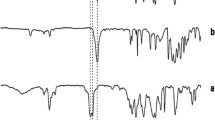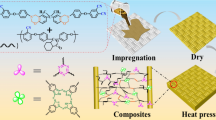Abstract
Bisphthalonitrile (BPh) resin was modified by diallyl bisphenol A/bismaleimide resin prepolymer (DP/BMI). Differential scanning calorimeter (DSC) and Fourier transform infrared spectroscopy were used to characterize the curing acceleration of modified bisphthalonitrile (MBPh) resin. The results show that DP/BMI resin has a good acceleration effect on the curing of BPh resin, and the peak temperature of MBPh resin was 250.6 °C. MBPh resin was blended with novolac cyanate ester (NCE) resin, and DSC, rheometer, and thermogravimetric analyzer were used to investigate the curing reaction thermodynamics, rheological properties, and heat resistance of MBPh/NCE resin system. The results show that the addition of MBPh resin had little impact on the lowest viscosity (1–6 Pa s) of NCE resin. The DSC peak temperature of MBPh/NCE resin decreased to 235.7 °C after adding 30 wt% of MBPh resin. The addition of MBPh obviously increased the temperature at 90% carbon yield of NCE resin, with the 90% carbon yield temperature rising by nearly 100 °C. The mechanical properties of MBPh/NCE resin system were evaluated by tensile properties, bend properties, impact strength, and fracture toughness. The results show that MBPh had little impact on the tensile properties and bend properties of MBPh/NCE resin, and slightly increased their impact strength and fracture toughness.












Similar content being viewed by others
References
Cao GP, Chen WJ, Wei JJ (2007) Synthesis and characterization of a novel bisphthalonitrile containing benzoxazine. Express Polym Lett 1:512
Yang X, Lei Y, Zhong J et al (2011) Preparation and thermal properties of novel phthalonitrile oligomer containing biphenyl ethernitrile/bisphthalonitrile blends. J Appl Polym Sci 119:882
Jiang M, Zou X, Huang Y et al (2016) The effect of bismaleimide on thermal, mechanical, and dielectric properties of allyl-functional bisphthalonitrile/bismaleimide system. High Perform Polym. https://doi.org/10.1177/0954008316667788
Xu YL, Dayo AQ, Derradji M et al (2018) Copolymerization of bisphthalonitrile/benzoxazine blends: curing behavior, thermomechanical and thermal properties. React Funct Polym 123:97
Wang AR, Dayo AQ, Lv D et al (2017) Novel amino-containing fluorene-based bisphthalonitrile compounds with flexible group: synthesis, curing behavior, and properties. High Perform Polym. https://doi.org/10.1177/0954008317725158
Kaliavaradhan K, Muthusamy S (2016) Synthesis and characterization of various phenylene diamine-based bismaleimide-containing phthalonitrile resins. Polym Bull 73:1921
Zhou S, Hong H, Zeng K et al (2009) Synthesis, characterization and self-promoted cure behaviors of a new phthalonitrile derivative 4-(4-(3, 5-diaminobenzoyl) phenoxy) phthalonitrile. Polym Bull 62:581
Singh AS, Shukla SK, Pandey AK et al (2017) Synthesis and evaluation of catalytic curing behavior of novel nitrile-functionalized benzoxazine for phthalonitrile resins. Polym Bull 74:1
Kaliavaradhan K, Muthusamy S (2016) Synthesis and characterization of various phenylene diamine-based bismaleimide-containing phthalonitrile resins. Polym Bull 73:1921
He S, Liang G, Wang J et al (2009) Mechanical and thermal properties of bisphenol A-based cyanate ester and diallyl phthalate blends. Polym Bull 62:237
Gu J, Dong W, Xu S et al (2017) Development of wave-transparent, light-weight composites combined with superior dielectric performance and desirable thermal stabilities. Compos Sci Technol 144:185
Wang J, Liang G, Wen Z et al (2006) Viscoelastic, thermal and mechanical properties of dicyclopentadiene bisphenol diyanate ester/epoxy co-polymers. Polym Bull 57:945
Reghunadhan Nair CP, Francis T (2015) Blends of bisphenol A-based cyanate ester and bismaleimide: cure and thermal characteristics. J Appl Polym Sci 74:3365
Gu J, Dong W, Tang Y et al (2017) Ultra-low dielectric fluoride-containing cyanate ester resins combining with prominent mechanical properties and excellent thermal and dimension stabilities. J Mater Chem C 5:6929
Gu A (2006) High performance bismaleimide/cyanate ester hybrid polymer networks with excellent dielectric properties. Compos Sci Technol 66:1749
Gu J, Xu S, Tang Y et al (2015) Fabrication of novel wave-transparent HMPBO fibre/BADCy laminated composites. RSC Adv 5:37768
Keller TM, Price TR (1982) Amine-cured bisphenol-linked phthalonitrile resins. J Macromol Sci Chem A 18:931
Sumner MJ, Sankarapandian M, McGrath JE et al (2002) Flame retardant novolac–bisphthalonitrile structural thermosets. Polymer 43:5069
Keller TM (1992) Strong organic acid cured phthalonitrile resins for high temperature applications. Polym Prepr 33:422
Gu J, Yang X, Li C et al (2016) Synthesis of cyanate ester microcapsules via solvent evaporation technique and its application in epoxy resins as a healing agent. Ind Eng Chem Res 55:10941
Acknowledgements
This work was financially supported by China Postdoctoral Science Foundation (Grant NO. 2018M640314), Postdoctoral Science Foundation of Heilongjiang Province of China (Grant NO. LBH-Z18260) and Natural Science Foundation of Heilongjiang Province of China (Grant NO. JJ2019LH2357).
Author information
Authors and Affiliations
Corresponding author
Additional information
Publisher's Note
Springer Nature remains neutral with regard to jurisdictional claims in published maps and institutional affiliations.
Rights and permissions
About this article
Cite this article
Li, H., Wang, D., Qu, C. et al. Preparation and performances of bisphthalonitrile resin and novolac cyanate ester resin blends. Polym. Bull. 76, 5649–5660 (2019). https://doi.org/10.1007/s00289-018-2663-9
Received:
Revised:
Accepted:
Published:
Issue Date:
DOI: https://doi.org/10.1007/s00289-018-2663-9




